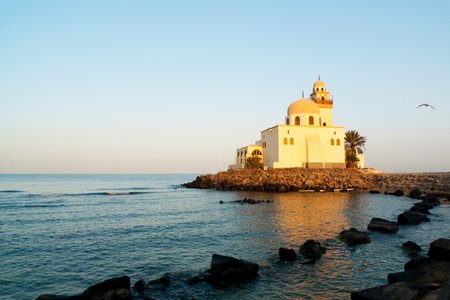Swapna Sundari
(First Draft.)
Jeddah
Was it when standing by the
low granite wall
bordering the Red Sea
watching the sun set
orange
with my friends and beloved family
and hearing the waves lap gently against the shore
or sitting on the floor alone
after they had left
in my room
with only the naked tubelight and the internet for company
that I knew
I would never be able to escape my only strength and weakness
you, yakshi and devatha
as without you
I could not write
poetry
having nothing and no one else to turn to
to inspire me
always, again and again
afresh and anew

Street in Old Jeddah [two views] -- Spencer W. Tart
Jeddah’s name is derived from “jaddah,” the Arabic word for grandmother, because the city contains the tomb of Hawwa (Eve), the grandmother of humanity. She was frequently mentioned in the Qur’an though not by name. After Allah created Adem (Adam ) from a handful of earth taken from the entire world (which explains why the various peoples are of different colors), he made "one soul and created from it its mate and dispersed from both of them many men and women" (Surah Al-Nisa 4:1). Also, Hawwa was not blamed for enticing Adem to eat the forbidden fruit of the Tree of Immortality; both of them “ate of it” and were equally to blame (Qur’an 20:121-122) and equally forgiven. (The Qur’an only mentioned one tree in Jannah [Eden], and Allah forbade Adem and Hawwa from eating of it, but Shaitan, disguised as a snake, called it the tree of immortality and persuaded both humans to disobey Allah. For the Shia, their action was not even a sin since obedience and disobedience are possible only on Earth and not in heaven, where Jannah was located.) In response Allah sent Hawwa to al-Marwah and Adem to al-Safa (two hills now both located in Al-Masjid Al-Ḥaram (The Sacred Mosque) in Makkah (Mecca) as his representatives. After Adem wept 40 days and repented, Allah sent down al-Ḥajaru al-Aswad (the "Black Stone" set into the eastern corner of the Kaaba) and taught him the principles of the Hajj. Adem and Hawwa reunited in the plain of ʻArafat, near Makkah, and had 1400 children, including Qabil (Cain) and Habil (Abel). After Allah rejected Qabil’s sacrifice, Qabil threatened to slay his brother, who Abel warned him that Allah only accepted the sacrifice of the righteous and that Qabil would carry the weight not only of his own sin but also of Habil’s. But Qabil slew him anyway, and Allah sent a crow who scratched the ground to show Qabil Cain how to hide the corpse. In some accounts, Adem and Hawwa had a younger son, Rocail, who created a palace and sepulcher containing autonomous statues that lived out the lives of men so realistically they were mistaken for having souls. In 1928 Sirdar Ikbal Ali Shah wrote that Hawwa, “must have been a lady of formidable proportions, for the original grave, I was told, was some eight feet long. It was as well, therefore, that she had not survived to welcome us in the flesh, for although it is rumored that we Muslims have an eye for ladies of heroic proportion we draw the line at the titanic. But I was told that the grave had mysteriously extended itself by the time I arrived to its present gigantic proportions” (which geographer Émile-Félix Gautier estimated to be about 130 meters long in 1931.) Due to religious objections against pilgrims praying at tombs, Aun Ar-Rafiq (Hajazi emir from 1882–1905) tried to demolish her tomb but let it stand due to public opposition. However, as Hejazi viceroy, in 1928 future Saudi king Fayṣal ibn ‘Abd al-‘Azīz Al Su‘ud destroyed it in 1928, and it was sealed with concrete by religious authorities in 1975.
ReplyDelete
ReplyDeleteThe yakshi of Hindu mythology were courtesans at Indra’s court, but those of Kerala were women who had died unnaturally and dwelt nocturnally in palm trees. Appearing as beautiful women, usually clad in white and emitting the fragrance of jasmine, they targeted lost travelers by asking them for some lime to chew with betel leaves. If the victims relented they would follow the yakshi back to their palace for carnal enjoyment. When the spell lifted the palace would be revealed as a palm tree and the traveler would be devoured except for a pile of hair and nails at the bottom of the tree. Scholars who offered the lime on the tips of their ezhuthani (iron pens used to write on palm leaves) would be immune to the spell, and mantravadis were able to nail them to kanjiram (Strychnos nuxvomica) trees; however, if the nail were removed the yakshi would be freed. In one account the scholar Vayaskarah Bhattathiri fell in love with a yakshi whom he had exorcised from the king of Calicut; she invisibly followed him and bore him a daughter only he could see, but after her birth the yakshi disappeared, leaving their child behind. The daughter became the family deity. In other contexts, a yakshi is a female earth spirit, accepted as a symbol of fertility by the Hindu, Buddhist, and Jain faiths, usually portrayed as a wide-hipped, voluptuous woman who can cause a tree to bear fruit simply by touching it with her foot.
Every human activity has its devata, its spiritual counterpart or aspect, a minor deva that serves some narrow purpose, such as vanadevatas (forest spirits), gramadevatas (village gods), devatas of river crossings, caves, mountains, etc., and the guardians of the cardinal directions. Other examples include apsaras (female spirit of the clouds and waters in Hindu and Buddhist mythology); heavenly maidens sent by Indra from Svarga Loka (the heavenly worlds on and above Mt. Meru where the righteous who have performed good deeds but are not yet ready to attain moksha live in paradise until their next incarnation) to seduce the meditating ascetics; and the gandharvas (the heavenly musicians).